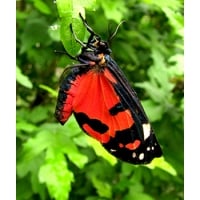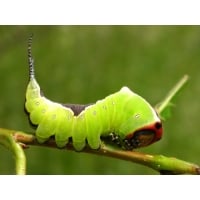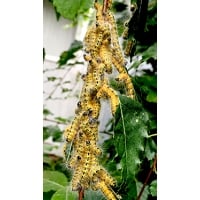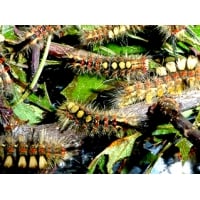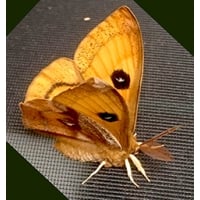SPRING and SUMMER EGGS and LARVAE Order now for supply in season
Scarlet Tiger Panaxia dominula
We suggest keeping newly-hatched larvae in a soft paper-lined size 7 plastic box on a fresh leaf of Sallow or Plum. These leaves are suggested because of their keeping qualities. The larvae quickly perforate the leaf which must be changed daily. When changing the leaf, the larvae readily drop off and curl up, before scattering, which gives the opportunity to make the change. But be quick! As the larvae grow they can be moved to a larger plastic box, for further growth before sleeving either on a potted foodplant (enclose the pot and plant), or on a branch of Plum or Sallow Salix caprea.
The larvae feed on Dead Nettle, Stinging Nettle, Willow, Sallow, Bramble, Sloe and Plum. They especially like Comfrey and Borage. They often browse on other hedgerow plants. Whilst, in the wild, these larvae would hibernate, if you keep them warm and well-fed, in captivity a second brood may be possible.
Pupation is amongst litter at the base of the foodplant and the magnificent day-flying moths emerge in June. Pairing is easy. Eggs are laid loose in the herbage and the tiny larvae feed for a while before hibernation at the base of the foodplant.
Hibernation in captivity may be done in several ways, but we now suggest hibernating them sleeved, pot and all, in a large pot of Comfrey, which should be kept out of doors in all weathers, and able to drain. In nature eggs are scattered loose amongst the foliage that the larvae like to feed on. The young larvae feed and grow for some weeks before hibernating deep in the base of ground foliage. In spring they resume feeding - their spectacular yellow and black patterning making a striking site on green foliage.
Scarlet Tigers fly by day - a wonderful sight on a sunny June day. In spring the colourful caterpillars are a joy to rear and very easy on potted foodplant.
Puss Moth Cerura vinula
An ideal beginner's species and an old favourite for the connoisseur. Larvae change frequently and become one of the strangest creatures. Curious forked tail with long red flagellae when disturbed. Foodplants are Poplars and Willows.
The caterpillar spins a concrete-hard cocoon of chewed bark, mixed into its own silk, producing a cocoon that is so camouflaged that it is very hard to see - see the picture - VERY hard to see!
Buff Tip Moth Phalera bucephala
The Buff Tip, once very common, is remarkable and a must for the enthusiast. You could help re-establish Buff Tips in your area. The eggs are laid in a tight cluster on a leaf of the foodplant. A hatched group of eggs is illustrated and you can see the skeletonised leaf left by the tiny larvae as they progress feeding across the leaf. The larvae are gregarious and quite conspicuous by the trail of eaten leaves, and the fact that they form quite a lumpy cluster!
They are coloured with a netted pattern of yellow and black, warning colours that ward off predators, and larger larvae have a covering of long, fine white silky hairs. The group does not disperse until pupation when they descend to burrow quite deep into the soil.
The moth is a master of deception, rolling its wings to form a silvery tube with extraordinary likeness at either end to a broken branch. If it flies up on being disturbed, it is hard to spot on landing, unless you know what you are looking for, because it so closely resembles a piece of branch. The larvae feed Maple, Birch, Hazel, Laburnham, Poplar, Prunus (Plums and Blackthorn), Oak, False Acacia Robinia, Hazel, Rose, Willows, Sallows, Lime, Elm, Viburnums.
We recommend Buff Tips as a great experience of nature.
Lappet Moth Gastropacha quercifolia
We don't get Lappets every year. This is quite special.
A magnificent species with fascinating, very large furry caterpillars that blend into their surroundings, and a moth that looks just like a bunch of leaves. Very easy to rear, sleeved on growing Blackthorn, Plum, Hawthorn or Apple.
The larvae grow to become a good size for hibernation, when they settle down the twigs and remain still for the winter.
Sleeve the larvae for the winter, using a double sleeve which protects better than single, during winter gales and helps prevent predators. In spring they awake and feed up rapidly, becoming giant and pupating in June. The cocoon is thin and papery. Inside the pupa is fragile and should not be disturbed. The moth is something that will amaze anyone seeing it for the first time!
Vapourer Moth Orgyia antiqua
Eggs are laid by the wingless female in a batch on the cocoon, where they pass the winter and hatch in spring.
Very interesting both for its moth and its very attractive and colourful caterpillar. Winter eggs are supplied for storage in the cool until spring. The larvae normally hatch in May/June or later, and feed on a wide variety of trees, which include Hawthorn, Willows and Sallows, most fruit trees, Hazel, Rose, Lime and Oak. The larvae are beautifully patterned and coloured, and decorated by prominent shaving brush-like tufts. The cocoon is spun amongst the foodplant.
The male moth is delicate, chestnut brown, with prominent feathered antennae, which are used to detect the wingless female, who emerges from the cocoon and rests on it, calling for a male. She lays her egg batch all over the cocoon where the eggs remain through the winter ready to start off the next generation.
Vapourer Moth Orgyia antiqua
Eggs are laid by the wingless female in a batch on the cocoon, where they pass the winter and hatch in spring.
Very interesting both for its moth and its very attractive and colourful caterpillar. Winter eggs are supplied for storage in the cool until spring. The larvae normally hatch in May/June or later, and feed on a wide variety of trees, which include Hawthorn, Willows and Sallows, most fruit trees, Hazel, Rose, Lime and Oak. The larvae are beautifully patterned and coloured, and decorated by prominent shaving brush-like tufts. The cocoon is spun amongst the foodplant.
The male moth is delicate, chestnut brown, with prominent feathered antennae, which are used to detect the wingless female, who emerges from the cocoon and rests on it, calling for a male. She lays her egg batch all over the cocoon where the eggs remain through the winter ready to start off the next generation.
Small Eggar Moth Eriogaster lanestris 20 larvae
The moths emerge in March/April. Because of modern practice of hedge management, this once common species is nowadays a rare find. Tight clipping of hedges destroys the habitat and undoubtedly the eggs and larvae.
Egg clusters are laid in batches on branches of the foodplant Blackthorn Prunus spinosa or Hawthorn Crataegus monogyna. The larvae cluster, and even large larvae live within, and on the outsite of a prominent white tent of silk, very often at the end of a branch, with no attempt at concealment. It is likely that the larvae in captivity could be reared on Apple and Plum, though we have not tried these.
Don't be tempted to handle the larvae. They have short, decorative hairs, which easily come away and penetrate the skin, like short cactus prickles, and this gives rise to intense irritation. No doubt this is why the larvae can afford to display themselves in the wild so openly. No predator will try to eat them once they learn, and the larvae are patterned in warning colours to advertise the danger.
To pupate, the larvae descend to form a tight cocoon with a smooth shell-like a nut, in concealed leaf litter or moss, where they spend the winter.
This is a very interesting species to rear and observe. You might help to spread the species locally if you can find thorn hedges that are not regularly trimmed.
Emperor Moth Saturnia pavonia
Britain’s only Silkmoth. The male and female have similar markings, but the female is larger, and the male is more brightly coloured. The Emperor Moth occurs in many rural areas but is particularly found on heaths, where they breed on Heathers. Eggs are laid in clusters on the heather, looking just like the dead flowerheads from last year.
The larvae feed on a variety of plants, including Bramble, Raspberry, Hawthorn, Blackthorn, Apple, Plum, Blackthorn, Oak, Hornbeam, Birch, Heathers and Heaths, Blueberry, Meadowsweet, Wild Rose, Sea Buckthorn, Purple Loosestrife, Willows especially Osier Salix viminalis, Pussy Willow (Sallow).
The caterpillars cluster in the early instars, eventually spreading out and becoming brightly coloured, as beautiful as such exotics as the Indian Moon Moth. The cocoon is spun in the foodplant. This is the stage that passes the winter. An interesting construction with a neck and open end, through which the adult emerges in spring. This is one of the fun species to rear.
Store cocoons in a cupboard until November. Then keep refrigerated until mid- February when they can be put in the emerging cage ready for hatching in March.
Ligurian Emperor Saturnia pavoniella
Although similar to our Emperor Moth pavonia, pavoniella is slightly larger and, in the male, has a much paler band on the hindwing inner margin. There are other differences in appearance and the intensity of pattern, particularly in the male.
Large larvae are quite distinct from those of pavonia. Foodplants are the same as for pavonia and include Apple, Plum, Blackthorn, Bramble, Hawthorn, Heather, WIllow, Birch, and many others. Pavoniella females pair several times (pavonia only once). Progeny of hybrids of pavonia with pavoniella are infertile, which indicates that pavoniella is a true species. Pavoniella is found in central Europe, extending south to Greece and for some distance into Turkey and well into Asia Minor.
Giant Peacock Moth Saturnia pyri
Europe's largest Moth! Larvae sleeved outside do well except in constant wet and cold weather. The large larva, with its apple green colouring and colourful spikey tubercles, is as handsome as the tropical Moon Moths.
The natural foodplants are Blackthorn and Hawthorn but they will often accept fruit trees such a Plum and Apple. Cocoons spun in summer produce moths in the following spring.
Tau Emperor Moth Aglia tau 15 eggs
This European Silkmoth flies in early spring and is one of the Silkmoths (Saturniidae).
The young larvae are adorned with antlers, as impressive as the American Hicory Horned Devils! Foodplants include Lime, Oak, Birch, Hawthorn, and other trees and shrubs. Single brooded. Rearing in sleeves is very successful. The larvae pupate amongst litter on the ground.
Very easy to breed: lay the pupae out in February for March/April emergence. The moths fly and pair by day, and particularly appreciate sunshine. Eggs are laid on the cage sides.
Highly recommended.
CEBALLOSI subspecies of Graellsia isabellae. Bustillo and Rubio 1974
This subspecies first officially recognised and described in 1974, is appreciably larger than the nominate form, and other subspecies. We have never had the opportunity to list isabellae ceballosi before and this is an opportunity not to be missed by the specialist breeder.
Ssp ceballosi is found in the north of Andalucia in Sierras de Segura and Cazoria, in South East Spain. As well as being measurably larger, the eye-spots, bands and other markings are more clearly defined.
Foodplants, as with isabellae isabellae, Pines, including Scotts Pinus sylvestris.

